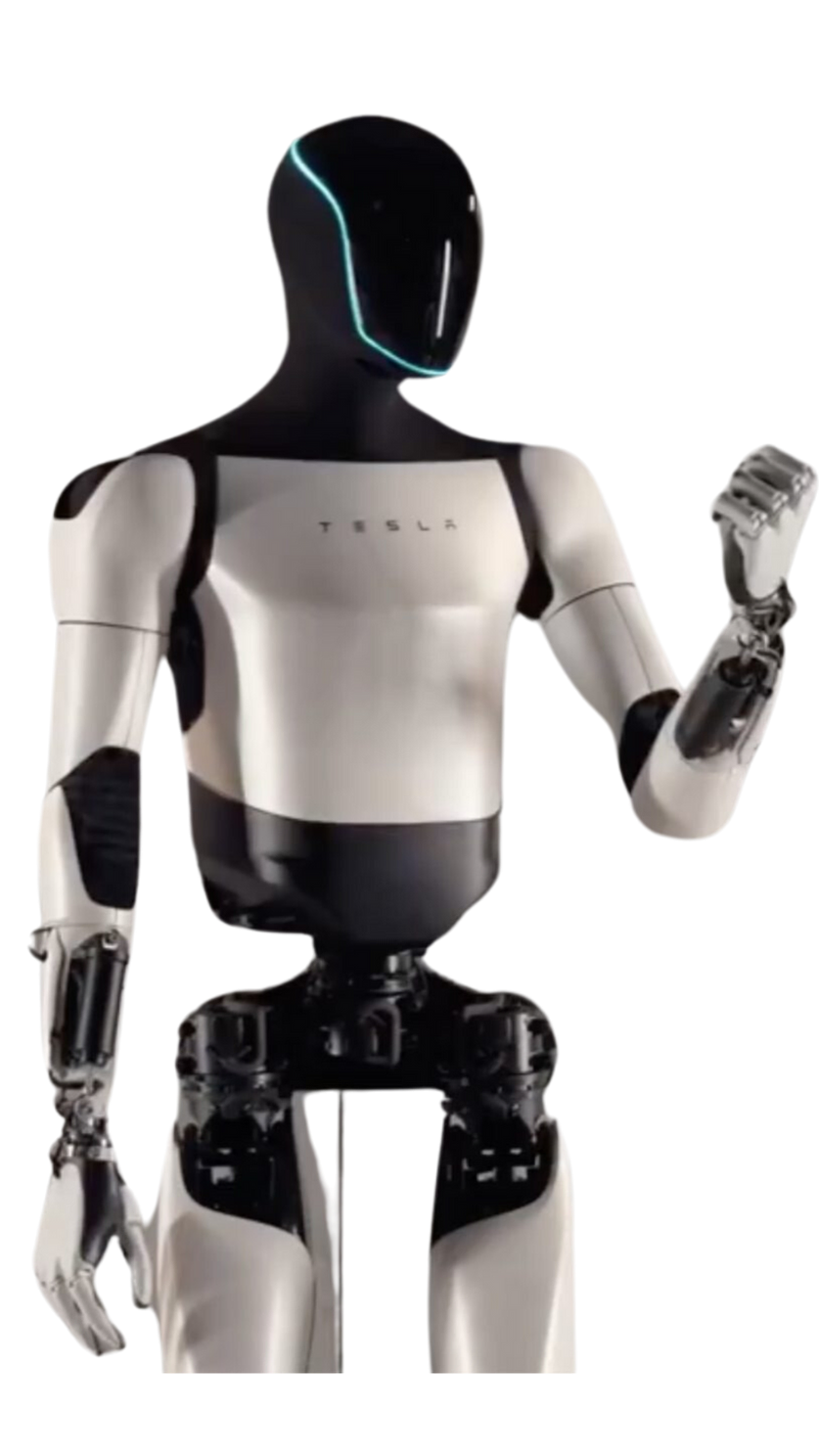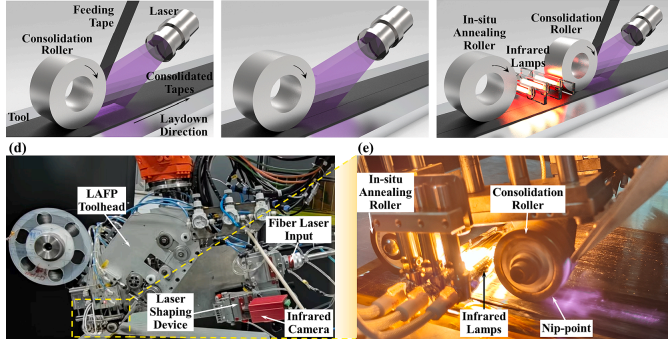In-Situ Infrared Annealing Breakthrough with Automated Fiber Placement for CF/PEEK Thermoplastic Composites
- Pravin Luthada
- May 6, 2024
- 5 min read
TLDR
Overcoming the Challenges of Laser-Assisted Automated Fiber Placement for High-Performance Thermoplastic Composites
Laser-assisted automated fiber placement (LAFP) is a promising manufacturing technique for producing high-complexity and large-size thermoplastic composite structures, such as those made from carbon fiber-reinforced polyether ether ketone (CF/PEEK). However, LAFP-manufactured parts often suffer from several critical weaknesses:
High porosity (>2%)
Low crystallinity (only 15-50% of autoclave/thermoformed parts)
Poor interlaminar properties (interlaminar shear strength only 15-50% of autoclave/thermoformed parts)
These issues arise primarily due to the extremely short time (<1 second) available for achieving interlaminar bonding during the LAFP process. Incomplete interlaminar contact leads to void formation, while insufficient interdiffusion of polymer chains results in suboptimal mechanical properties.
Existing approaches to address these challenges include:
Method | Description | Drawbacks |
Elevating tool temperature | Enables isothermal crystallization within processing window | Less feasible for large parts |
Post-consolidation (autoclave, thermoforming) | Provides time for interdiffusion and consolidation | Additional processing time and energy |
Repass treatment | Multiple localized heatings promote interlaminar bonding | Significantly reduces laydown efficiency |
While these techniques can improve part quality, they either increase complexity or reduce the manufacturing efficiency that makes LAFP so attractive in the first place. Therefore, there remains a strong need for an LAFP manufacturing strategy that can simultaneously optimize both part quality and production efficiency for high-performance thermoplastic composites like CF/PEEK.
Poor Interlaminar Properties and Inefficient Laydown in LAFP-Manufactured CF/PEEK Composites
The extremely short time available for interlaminar bonding during laser-assisted automated fiber placement (LAFP) often leads to poor consolidation quality in the resulting CF/PEEK composite parts. Key problems include:
High porosity (4.87% in untreated LAFP samples)
Incomplete intimate contact → interlaminar voids
Entrapped air cannot fully escape
Low crystallinity (only 18.6% in untreated LAFP samples)
Insufficient time above melt temperature for crystals to form
Rapid cooling rates (up to ~200°C/s) limit polymer chain mobility
Weak interlaminar strength
Interlaminar shear strength (ILSS) of untreated LAFP parts only 19.5 MPa
Mode I interlaminar fracture toughness (GIC) also very low
These poor interlaminar properties severely restrict the use of LAFP-manufactured thermoplastic composites in demanding aerospace applications. Current methods to improve part quality, such as elevating tool temperature, offline autoclave/ thermoforming post-consolidation, or laser repass treatments, all introduce additional cost and complexity while reducing the baseline speed and efficiency of the LAFP process.
The need to interrupt tape laying for multiple localized repass heating steps is especially detrimental to LAFP laydown rates. For example, applying a typical repass treatment to a 30-ply CF/PEEK laminate can double the required manufacturing time compared to single-pass LAFP. Therefore, the CF/PEEK composites industry requires an LAFP processing innovation that enhances interlaminar properties to aerospace-grade levels without compromising on laydown efficiency.
Investigating In-Situ Infrared Annealing for Simultaneous Improvement of Interlaminar Properties and Manufacturing Efficiency
To address the challenges of poor interlaminar properties and reduced laydown efficiency in LAFP-manufactured CF/PEEK composites, the authors investigated an in-situ infrared annealing (IIA) approach. The key aspects of the IIA process are:
Infrared heating applied by three 1000 W lamps positioned close to the laid-down tape
Second compaction roller applies additional pressure after the infrared heating zone
Both tape deposition and annealing occur within a single pass, maintaining high laydown rates
The researchers systematically compared the effects of IIA processing to untreated and laser repass treated LAFP samples:
Nip-point temperature histories measured by embedded thermocouples
Porosity evaluated by acid digestion method
Degree of crystallinity determined by differential scanning calorimetry (DSC)
Part distortion characterized by vertical warpage distance
Interlaminar shear strength (ILSS) measured by short beam shear test
Mode I interlaminar fracture toughness (GIC) assessed by double cantilever beam (DCB) test
Fractography analysis using scanning electron microscopy (SEM)
Key findings demonstrate that IIA can provide heating power up to 700 W, sufficient to:
IIA Power | Effect |
300-500 W | Exceed T_melt in first ply |
500-600 W | Exceed T_melt in top 2 plies |
700 W | Partially melt 3rd ply, fully melt and slowly cool top 2 plies |
This localized remelting and slow cooling enables void reduction, polymer healing, and stress relief through IIA. The slow cooling rates (30-70% lower than repass) also promote high crystallinity.
Unlike repass treatments that require multiple heating steps, IIA achieves high crystallinity (up to 33.8%) within a single tape laying pass. This makes IIA a promising method to obtain aerospace-grade interlaminar properties in LAFP-manufactured CF/PEEK composites without sacrificing laydown efficiency.
Achieving High Quality and High Efficiency LAFP of CF/PEEK Composites through In-Situ Infrared Annealing

The in-situ infrared annealing (IIA) method proved highly effective at enhancing the quality of LAFP-manufactured CF/PEEK composites while maintaining high laydown rates. Compared to untreated LAFP samples, laminates produced with 700 W IIA showed:
57.9% reduction in porosity (from 4.87% to 2.05%)
Localized remelting and slower cooling allows voids to be squeezed out
89.2% increase in crystallinity (from 18.6% to 33.8%)
Partial melting of up to 3 plies and gradual solidification promotes polymer chain alignment
239.7% increase in ILSS (from 19.5 MPa to 65.9 MPa)
292.4% increase in propagation GIC (from 175.1 J/m2 to 685.9 J/m2)
Enhanced intimate contact and polymer healing strengthens interlaminar region
These mechanical properties are comparable to those achieved by laser repass treatment (ILSS = 72.3 MPa, GIC = 751.2 J/m2) while maintaining the full laydown speed of single-pass LAFP. The IIA method also provides more consistent crystallinities through the laminate thickness and reduces warpage by 78.6% compared to untreated LAFP.
Key advantages of in-situ infrared annealing over other LAFP enhancement techniques include:
Technique | Drawbacks | IIA Advantages |
Repass | Multiple heating steps reduce laydown rate | Single-pass processing maintains efficiency |
Autoclave | Extremely low efficiency, additional costs | In-situ integration, no extra equipment |
Thermoforming | Long cycle times, only for simple geometries | Adaptable to complex shapes, fast layup |
By achieving aerospace-grade mechanical properties in a single efficient laydown pass, in-situ infrared annealing provides an attractive new solution for high quality, cost-effective LAFP manufacturing of thermoplastic composites. This breakthrough could help expand the use of materials like CF/PEEK in demanding lightweight structures across the aerospace, automotive, and renewable energy industries.
References
I would like to express my gratitude to the authors of the research paper "In-situ infrared annealing for laser-assisted automated fiber placement to enhance interlaminar properties without sacrificing laydown efficiency" - Xukang Wang, Cheng Chen, Shirui Hu, Zhikun Chen, Wei Jiang, Guancheng Shen, Zhigao Huang, and Huamin Zhou from the State Key Laboratory of Materials Processing and Die & Mould Technology, School of Materials Science and Engineering, Huazhong University of Science and Technology. Xukang Wang, Cheng Chen, Shirui Hu, Zhikun Chen, Wei Jiang, Guancheng Shen, Zhigao Huang, and Huamin Zhou's innovative research on the in-situ infrared annealing (IIA) method for enhancing the interlaminar properties and manufacturing efficiency of laser-assisted automated fiber placement (LAFP) of CF/PEEK composites provided the foundation and inspiration for this article. The novel approach and thorough experimental work presented in their paper were instrumental in developing the content and key takeaways shared here.
I appreciate Xukang Wang, Cheng Chen, Shirui Hu, Zhikun Chen, Wei Jiang, Guancheng Shen, Zhigao Huang, and Huamin Zhou's dedication to advancing composite manufacturing techniques and their clear, detailed presentation of the challenges, methods, and results. Their work has made a significant contribution to the field and opens up exciting new possibilities for high-performance thermoplastic composite fabrication.
What's Next!

Robotics Power displayed through Tesla Optimus Robot
Discover the future of composite manufacturing with Addcomposites! Here's how you can get involved:
Stay Informed: Subscribe to our newsletter to receive the latest updates, news, and developments in AFP systems and services. Knowledge is power, and by staying informed, you'll always have the upper hand. Subscribe Now
Experience Our Technology: Try our cutting-edge simulation software for a firsthand experience of the versatility and capability of our AFP systems. You'll see how our technology can transform your production line. Try Simulation
Join the Collaboration: Engage with us and other technical centers across various industries. By joining this collaborative platform, you'll get to share ideas, innovate, and influence the future of AFP. Join Collaboration
Get Hands-On: Avail our educational rentals for university projects or semester-long programs. Experience how our AFP systems bring about a revolution in composite manufacturing and leverage this opportunity for academic and research pursuits. Request for Educational Rental
Take the Next Step: Request a quotation for our AFP systems. Whether you're interested in the AFP-XS, AFP-X, or SCF3D, we are committed to offering cost-effective solutions tailored to your needs. Take the plunge and prepare your production line for the next generation of composite manufacturing. Request Quotation
At Addcomposites, we are dedicated to revolutionizing composite manufacturing. Our AFP systems and comprehensive support services are waiting for you to harness. So, don't wait – get started on your journey to the future of manufacturing today!








Comments